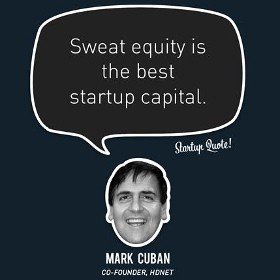
“If you’ve got a dream and your dream doesn’t require a team, you need to dream bigger.” — Unknown
When working with startups (both as an investor and advisor), I like to focus on incentivizes. The more aligned your organization is, the better the performance will be.
Commissioned sales people are hustlers. Ever buy a used car? They do anything to get the sale, but they don’t care about the dealership. The majority of their compensation comes from sales. They don’t get a piece of the bigger pie, so why help other salesmen? It is a bit of a dog eat dog world.
The other extreme (Corporate America) is just as bad.
If you are working at a startup, you don’t want just a job. Your goal isn’t simply a paycheck and benefits — you want meaning. And upside.
Founders are crazy. They have to be to fight to bring something radical new way to the world. And they magnetize others to follow them.
But early startup employees are crazy too. They believe in the vision of building something bigger — but they also “own” the company in a sense. This is their baby, they have a stake and they create the culture from day one.
But it isn’t all fun and games…
A pirate’s life for me?
Being a pirate is a lot like joining a startup — a rebel on the high seas setting sail into the unknown in search of treasure and adventure. And the seas aren’t smooth, anything but actually. But the rewards can be life changing.
For ships to function, the entire crew must be aligned. Every mate has his (or her) job. Everyone relies on everyone else. There is little room for error, and the opportunities to die are endless.
The pirate captain
Everyone knows the captain’s in charge — at least that’s the myth. The reality, much like any situation is that leaders succeed (and survive), only when their crew permits it. Too much trouble, running out of food, stock price plummeting… mutinies occur. The collective pick the person most able to help them achieve their goals. If it is not you, you are out.
It is a bit like game theory.
That is the motivation for this post: the pirate’s riddle. In essence, a captain has 100 gold coins. How does he divide them among the 4 members of crew to maximize his share — keep in mind the majority can throw him overboard if they feel cheated (here is the riddle if you want to try and solve it).
The riddle isn’t important, the consideration of others in the equation, specifically the equity equation is.
Startup equity
How much is too much?
That is the number one question I get from founders. We are hiring a VP of this or a head of that and I don’t know how much equity to give them.
Fred Wilson has a great system here, but says
“for your first key hires, three, five, maybe as much as ten, you will probably not be able to use any kind of formula”.
Alternatively, Leo Polovets of Susa Ventures presents another well thought out, data-supported strategy.
- At 1–10 person companies, 0.5% — 2.0% is a pretty common range, though some companies fall outside of this range.
- For 11–50 person companies, 0.1% — 1.0% is typical.
- For 51–200 person companies, 0.01% — 0.2% is typical.
The truth is there is no perfect formula.
Instead I encourage founders to consider the pirate example: see things from the other’s eyes. A smaller piece of a big pie still beats a personal pan pizza. But this can get founders in trouble as well. Being too free-wheeling with equity is dilutive and dangerous (although Sam Altman of YCombinator recommends being even more generous with equity).
Investors especially focus on this. I won’t invest if I believe the dilution required from future capital raises will demotivate the founder.
At a certain point, you can only give away so much of your company before it doesn’t feel like yours anymore. This is a trap. When founders own too little, the drive to build dies. It becomes a situation of a forced sale (or CEO replacement).
Somehow investors want liquidity. And if the founder isn’t the one to bring the business to the promised land, the board will oust them.
No founder wants that.

Source: Moziru
(For a well thought out growth plan on equity and future employees/dilution, see this post by Andy Rachleff, CEO of Wealthfront and Partner at Benchmark)
Company culture: more than just equity
Sure shares are great, but ownership of an idea is often better. Employees NEED to feel part of the mission. The best founders create this culture early on. They work the phones, handle customer service, ask employees for advice and suggestions and create relatively flat organizations.
There are many ways to make employees feel empowered. Here are 3 of my favorites:
- Transparency/Company Updates — Think investors updates but for employees. In a startup, it is easier to trust the captain when you are kept in the loop and see where the ship is headed.
- Epic Job Titles (or none at all) — Bonobos has Customer Service Ninjas. That feels and sounds significantly cooler and more important than customer service agent (and gets way more applicants). Make every role mission critical.
- Encourage Brainstorming/Debate — Ray Dalio of Bridgewater Associates (world’s largest hedge fund with $160B AUM) has a policy of “idea meritocracy”, where everyone has a say and the best decisions win out
Game theory and investors
The dynamics above are similar for investors as well. VCs and angel investors invest to make money, and they need returns to stay in the game. By working with your company, they signal that they believe in your startup.
But not all investors are created equal. As a founder, you must weigh investment offers carefully. All money isn’t good money.
Sure, all cash keeps the ship afloat but specific capital often accelerates progress.
Sequoia or Benchmark can open doors for founders. Simply being funded by the darlings of Silicon Valley will get you meetings and give credibility to the investor community. And it helps with recruiting, and sale. Plus you will probably need more money, and Sequoia leads all VCs , continuing to follow on with 87% of their investments.
The network is key too. Different investors run in different circles. And depending on your product and business, certain investors add significantly more value than others. This is especially true for industry specific funds/investors. When a firm has industry experience, complementary portfolio companies and connections to the enterprise buyers, they bring a lot to the table.

Source: Flickr
And accordingly, you think long and hard about their offer, even if it is below market rate. The right partner puts you on a path to a bigger pie.
But investors are not everything. They are a small piece of the puzzle. And if one specific investor will make or break your company, you have bigger problems. Investors look for entrepreneurs that will succeed on their own, no matter what. We want to add fuel to these fires to help accelerate growth.
[LIKE THIS ARTICLE SO FAR? THEN YOU’LL REALLY WANT TO SIGN UP FOR MY NEWSLETTER OVER HERE — AND GET SOME FREE BONUSES!]
The bidding war
When deals get hot, they can get dangerous. As a founder with a rapidly rising valuation, it is hard to see how you can get burned. You can.
The problem with valuations is expectations. Raise too high and the next round MUST exceed it. No one wants a downround. And $10M pre vs $20M pre have VASTLY different metrics.
Work with investors or advisors to plan out future fundraising. They should be able to help you with targets to aim for.
As a rule of thumb, Series A investors want at least $100k in MRR (monthly recurring revenue). Many founders are shocked by (specifically by the amount of traction needed). But the fact is, if you don’t understand expectations you will come up short and fail to raise — or raise with bad terms.
Think carefully about this. The valuation isn’t the end game. It isn’t even that important. Equity ownership of a rocketship is. Don’t get seduced by the big numbers…
The problem with VCs
Most venture firms need to own at least X% of the company to make the economics work. This presents problems when you want less money. If you are looking to raise $1M at a $10M pre and Andressen “has to have” 20% of the company to invest, you are looking at 83.3% more dilution.
Here competition can help. The more investors interested in your company, the more leverage you have. If Andressen really wants in and other investors are willing to match your ask, you might be able to negotiate.
The flip side
Raising money at good terms when you can is almost always a good idea. You never know when the capital markets will change or a key aspect of your business will fail. A war chest allows your team to continue or pivot as necessary — without relying on outside capital.
And in business, nothing is ever guaranteed.
Many investors are understandably wary of bridge rounds. “Is it a bridge just to nowhere?” That is the question.

Source: Wikiality
But with money in the bank, that isn’t important. An extended runway lets startups figure things out, even make a few mistakes and still have a shot on goal…
It is your choice.
Riding off into the sunset…
The best startups are like special forces — a deadly unit where everybody busts their ass, does the dirty work and keeps fighting until the bitter end.
And while developers might not take a bullet, their hardcore obsession with the mission drives disruptive innovation. 100+ hour work weeks are not uncommon — everyone is 100% committed (especially if they have equity…)
And while it is unhealthy, it is often what’s needed to succeed. Startups try to do the impossible — they take on the world, and they win. That takes superhuman effort.
You are asking employees to risk everything to make your dream a reality. The best way to accomplish a dream is to help your team accomplish theirs.
Look at equity, look at incentives, look at culture — each plays a critical role.
Closing thoughts
Pirates are pretty cool. So are startups. But the truth is both are glamorized. It is a hard life filled with ups, downs and uncertainty. The thing is, having an awesome crew can get you through tough times.
For founders: How have you handled equity in the past?
For investors: Any advice from portfolio companies?
Would love to hear hear perspectives and opinions from in the comments below.
This is a hard balancing act — but getting it right and sets your startup up for success.
And remember, 10x employees are irreplaceable. Hire the best and you will always beat the rest.
Learned something? Click the share buttons to say “thanks!” and help others find this article.
Originally posted on Medium
Hi! I am a robot. I just upvoted you! I found similar content that readers might be interested in:
https://hackernoon.com/how-founders-can-avoid-screwing-up-the-equity-equation-game-theory-b3a96db3519d